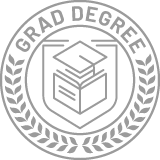Doctor’s Degrees in Computer Software & Applications
Featured schools near , edit
Education Levels of Computer Software Majors
In 2020-2021, 9 earned their doctor's degree in computer software. This makes it the 224th most popular doctor's degree program in the country.
The following table shows the number of diplomas awarded in computer software at each degree level.
| Education Level | Number of Grads |
|---|---|
| Master’s Degree | 3,555 |
| Graduate Certificate | 483 |
| Doctor’s Degree | 9 |
Earnings of Computer Software Majors With Doctor’s Degrees
We are unable to calculate the median earnings for computer software majors with their doctor's degree due to lack of data.
Student Debt
We do not have the data to calculate the median and range of debt loads for computer software students who are doctor's degree holders.
Student Diversity
More men than women pursue doctor's degrees in computer software. About 77.8% of graduates in this field are male.
| Gender | Number of Grads |
|---|---|
| Men | 7 |
| Women | 2 |

The racial-ethnic distribution of computer software doctor’s degree students is as follows:
| Race/Ethnicity | Number of Grads |
|---|---|
| Asian | 1 |
| Black or African American | 1 |
| Hispanic or Latino | 1 |
| White | 3 |
| International Students | 3 |
| Other Races/Ethnicities | 0 |

Most Popular Computer Software Programs for Doctor’s Degrees
There are 7 colleges that offer a doctor’s degree in computer software. Learn more about the most popular 7 below:
The most popular school in the United States for computer software students seekinga doctor's degree is Georgia Institute of Technology - Main Campus. The average in-state tuition for full-time undergraduates is $10,258 per year, while in-state graduate students, on average, pay $14,570 per year. For the 2020-2021 academic year, 3 doctor's degrees were handed out to computer software majors at Georgia Tech.
The most popular school in the United States for computer software students seekinga doctor's degree is University of Baltimore. Each year, around 4,100 students seeking various degrees attend the university. The average in-state tuition for full-time undergraduates is $7,154 per year, while in-state graduate students, on average, pay $14,094 per year. The computer software program at University of Baltimore awarded 3 doctor's degrees during the 2020-2021 school year. Around 33% of these students were from an underrepresented racial-ethnic group, and 67% were women.
The 3rd most popular school in the country for computer software majors who are seeking their doctor's degree is University of California - Santa Cruz. The average in-state tuition for full-time undergraduates is $11,442 per year, while in-state graduate students, on average, pay $11,442 per year. The computer software program at University of California - Santa Cruz awarded 2 doctor's degrees during the 2020-2021 school year.
Naval Postgraduate School is the 4th most popular school in the nation for students seeking a doctor's degree in computer software. For the 2020-2021 academic year, 1 doctor's degrees were handed out to computer software majors at Naval Postgraduate School.
Explore Major by State
Alabama
Arkansas
Connecticut
Florida
Idaho
Iowa
Louisiana
Massachusetts
Mississippi
Nebraska
New Jersey
North Carolina
Oklahoma
Rhode Island
Tennessee
Vermont
West Virginia
Related Majors
Below are some popular majors that are similar to computer software that offer doctor’s degrees.
| Major | Annual Degrees Awarded |
|---|---|
| Computer Science | 1,252 |
| Computer Information Systems | 984 |
| Information Science | 194 |
| Information Technology | 121 |
| Other Computer Sciences | 20 |
References
*The racial-ethnic minority student count is calculated by taking the total number of students and subtracting white students, international students, and students whose race/ethnicity was unknown. This number is then divided by the total number of students at the school to obtain the percentage of racial-ethnic minorities.
- College Factual
- National Center for Education Statistics
- O*NET Online
- Bureau of Labor Statistics
- Image Credit: By Negative Space under License
More about our data sources and methodologies.
Featured Schools
 Request Info
Request Info
|
Southern New Hampshire University You have goals. Southern New Hampshire University can help you get there. Whether you need a bachelor's degree to get into a career or want a master's degree to move up in your current career, SNHU has an online program for you. Find your degree from over 200 online programs. Learn More > |





